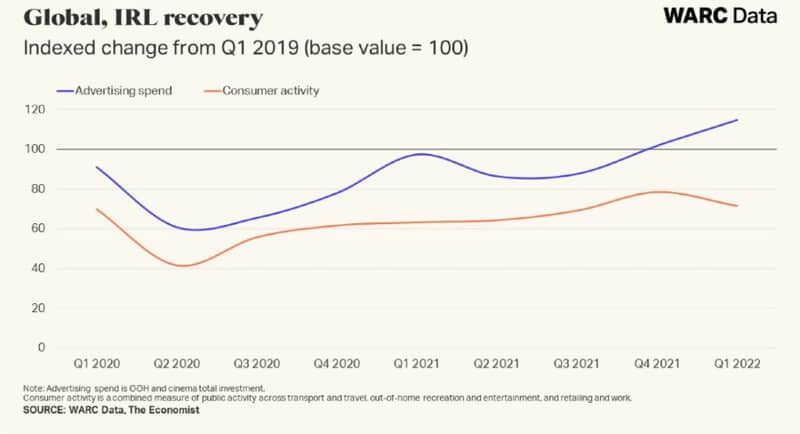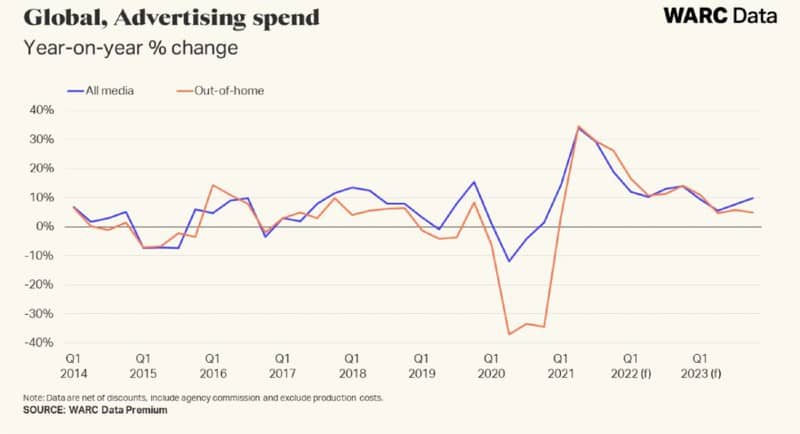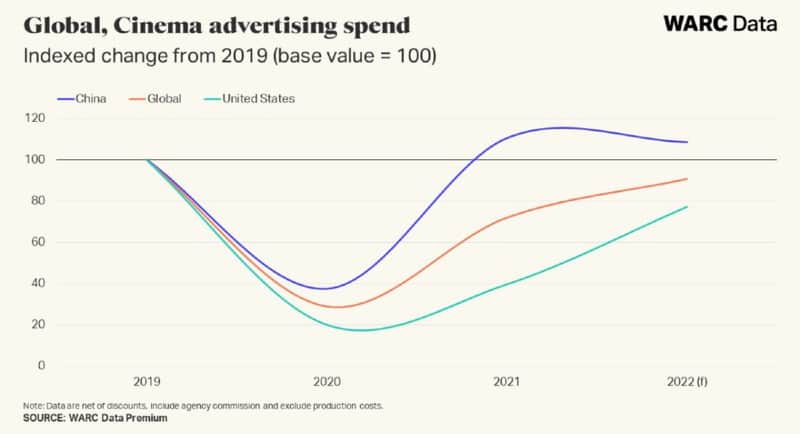New WARC analysis comparing global ad spend with citizens mobility data has revealed that the recovery of investment in out-of-home and cinema is exceeding the return of consumer activity to pre-pandemic levels.
As consumers around the world return to offices restaurants and physical retail stores, WARC examined the health of the advertising experienced by consumers when they leave their home, such as out-of-home (OOH) and cinema media, which the report dubbed: ‘IRL (in real life) ad economy’ and online includes paid media, and may benefit from further analysis of sponsorship, events and in-store activity.
WARC data compared global OOH and cinema ad spend with The Economist’s ‘normalcy index’, it tracked public activity across transport, recreation, retailing and work. WARC’s forecast shows that IRL ad spend worldwide will reach $44.4 billion in 2022, a shortfall of $0.7 billion on the $45.1 billion spent in 2019, but nonetheless tracking ahead of consumer activity levels.
The recovery will continue into 2023 when the IRL ad market will reach a new high of $47.1 billion.
Few parts of the media industry saw fortunes fluctuate during the pandemic to quite the extent as experienced in out-of-home. OOH media owners are beginning to claw back some of the ad investment lost during the pandemic.

A 16.5% year-on-year increase is forecast for Q1 2022, reaching $10.9 billion globally, with growth slipping back to 11.0% in Q1 2023.
However, the recovery from COVID-19 may only be completed in 2023. Out of a dozen major markets analysed by WARC Data, only Australia (+1.5%) and the United States (+0.9%) can expect OOH ad spend in 2022 to match or better total annual ad revenues from 2019.
The OOH spend slump is most pronounced in India (-42.1%) and Brazil (-27.4%), while investment in Italy is forecast to be 21.0% down on pre-COVID levels.
Rising OOH media costs represent a further cause for concern for brands. Global inflation in the channel hit 9.4% in 2021, and is forecast to reach 4.6% in 2022, as advertiser demand increases and the costs of running digital signage increase in light of rising energy prices.

Box office hits like Spider-Man: No Way Home suggest COVID-19 has not extinguished the enduring appeal of an outing to movie theatres. Nevertheless, these remain tricky times for cinema media owners.
Annual global ad spend on cinema will reach $3.4 billion in 2022, some way short of the peak of $3.8 billion in 2019. At a market level, the US cinema ad sales hit only $301.5m in 2021, 60.3% lower than total revenues in 2019.
The great exception to cinema’s global struggles is the significant increase in ad spend seen in China. Tellingly, two of the three highest-grossing films of 2021 worldwide were Chinese productions (The Battle at Lake Changjin II: Water Gate Bridge and Hi, Mom).

The popularity of local content is reflected in a buoyant Chinese cinema ad market, which reached CNY7.0 billion ($1.1 billion) in 2021, up 10.4% on pre-COVID revenues.
Alex Brownsell, head of content, WARC Media, and author of the report, said: “Consumers live increasingly digital lives. People are more likely to work from home and shop online. Brands are preparing for a future dominated by virtual interactions in the metaverse. However, it’s vital that marketers do not neglect those all-important physical moments between our digital experiences.
“WARC’s analysis of the IRL ad economy shows that brands understand the role that channels like OOH and cinema play in the media mix, and that they are investing ahead of activities such as commuting, in-person socialising and in-store shopping returning to pre-pandemic levels.”